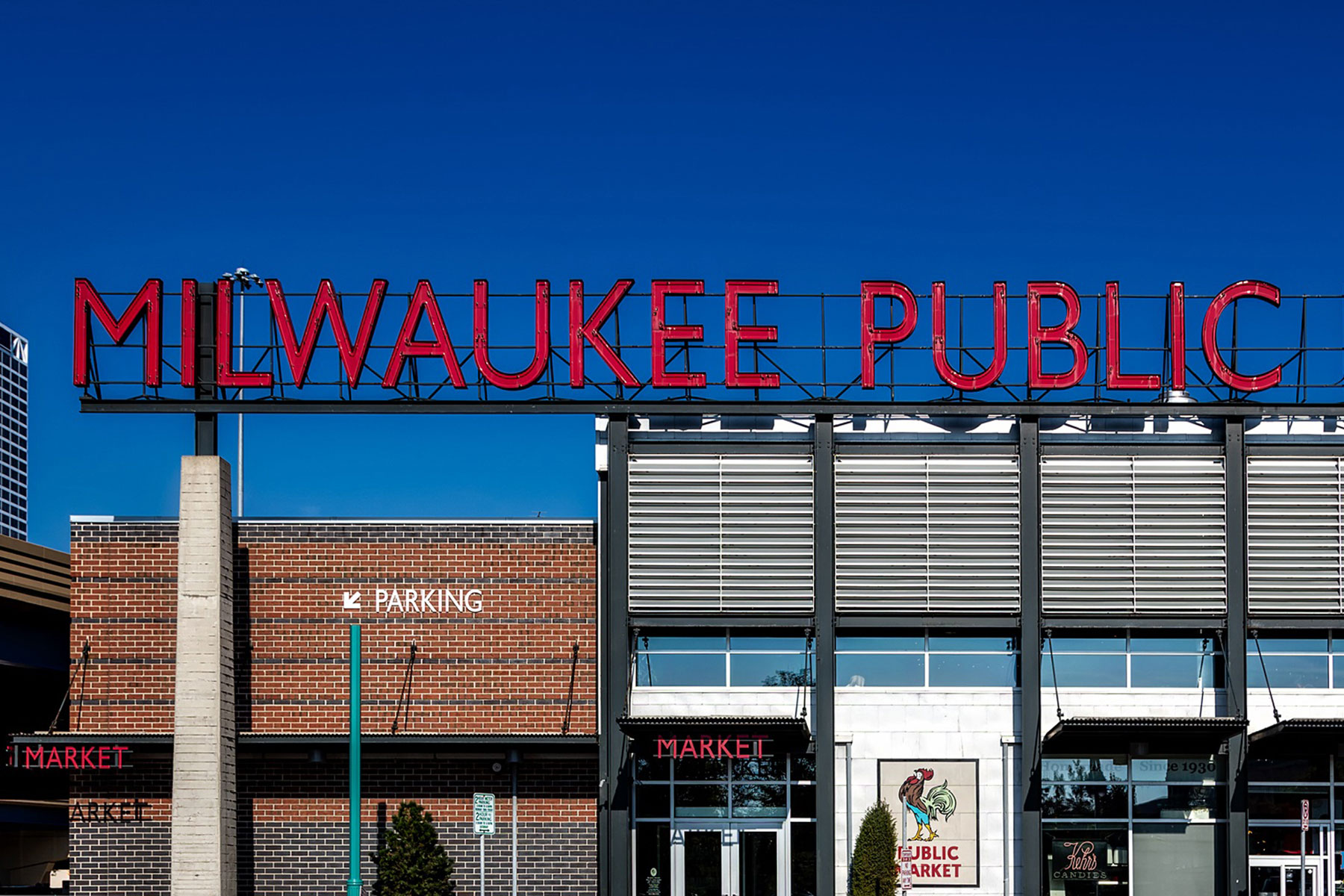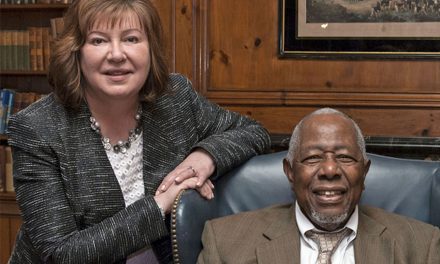
Marquette Law School published the results of its Milwaukee Area Project Poll for October 9 to 17, covering residents in Milwaukee, Waukesha, Ozaukee, Washington, and Racine counties.
A new Marquette Law School Poll of residents in Milwaukee and surrounding counties finds that 54 percent of adults believe a new Foxconn factory in Racine County will substantially improve the economy of the Milwaukee area, while 37 percent think it will not. At the same time, 48 percent think the $3 billion in state incentives to Foxconn to be more than the plant is worth, while 38 percent believe the factory will provide that much or more in benefits to the state. Twenty-nine percent of Milwaukee area respondents think they or their families will directly benefit from the Foxconn factory, with 65 percent saying they will not personally benefit.
The poll results on Foxconn and other important issues facing the Milwaukee metropolitan area were released Tuesday as Marquette Law School hosted the inaugural event for its Lubar Center for Public Policy Research and Civic Education.
A half-day conference at the Law School included the debut of the Milwaukee Area Project (MAP), a long-term research effort of the Lubar Center, which will provide detailed information about metropolitan trends. The conference also featured speeches by Milwaukee Mayor Tom Barrett and Waukesha County Executive Paul Farrow, who addressed the region’s future, and keynote remarks from former Minneapolis Mayor R.T. Rybak, President and CEO of The Minneapolis Foundation. The Lubar Center is supported by a $7 million gift to the Law School from Milwaukee philanthropists Sheldon and Marianne Lubar, who were honored at the event.
The polling results on Foxconn offer the first in-depth look at public sentiment in this region about the planned factory for building flat-screen displays. The poll finds that 71 percent of Racine County residents say the Foxconn factory will improve the area’s economy and 23 percent don’t think so. In Ozaukee and Washington counties combined (hereafter “Ozaukee/Washington”), 67 percent expect an economic boost, as do 59 percent in Waukesha County, 55 percent in Milwaukee County outside the city (hereafter “suburban Milwaukee County”), and 40 percent in the City of Milwaukee. Those who doubt a substantial economic impact make up 27 percent in Ozaukee/Washington, 32 percent in Waukesha County, 35 percent in suburban Milwaukee County and 50 percent in the City of Milwaukee.
Those who think the plant will provide economic gain that comes to as much as or more than the $3 billion in state incentives make up 56 percent in Ozaukee/Washington, 48 percent in Waukesha County, 42 percent in Racine County, 37 percent in suburban Milwaukee County and 23 percent in the City of Milwaukee. Those who think the Foxconn factory will not be worth that much to the state are 34 percent in Ozaukee/Washington, 39 percent in Waukesha County, 47 percent in Racine County, 51 percent in suburban Milwaukee County and 58 percent in the City of Milwaukee.
Racine residents are most likely to say they or their families will directly benefit, at 49 percent, while 34 percent in Waukesha County, 29 percent in Ozaukee/Washington counties, 28 percent in suburban Milwaukee County and 20 percent in the City of Milwaukee expect to directly benefit. Those who say they will not directly benefit make up 47 percent in Racine County, 61 percent in Waukesha, 68 percent in Ozaukee/Washington, 68 percent in suburban Milwaukee County and 72 percent in the City of Milwaukee.
The Marquette Law School Poll of the Milwaukee area was conducted Oct. 9-17 with 1,200 adult residents of Milwaukee, Ozaukee, Racine, Washington and Waukesha counties. The margin of error is +/- 3.5 percentage points for items based on the full sample. Margins of error for the individual counties and for the City of Milwaukee are larger. Full details are provided in the methodology statement below.
Economic conditions
Nine percent of those polled rate economic conditions in their community as excellent, with 42 percent saying conditions are good, 33 percent rating them only fair, and 14 percent calling economic conditions poor. Looking to the future, 11 percent think the economy will get much better over the next 10 years, 30 percent say somewhat better, and 32 percent think conditions will remain about the same, while 13 percent think conditions will become somewhat worse and 9 percent say much worse.
Nine percent of Milwaukee area residents rate job opportunities for young people in their communities as excellent, with 30 percent saying opportunities are good, 38 percent fair and 18 percent poor.
There are substantial differences in economic perceptions between the wealthy suburban counties and the less well-off parts of the Milwaukee area. Seventy-eight percent of Ozaukee/Washington and 76 percent of Waukesha residents rate their community economic conditions as excellent or good, compared to 22 and 25 percent respectively rating them fair or poor. Fifty-eight percent of suburban Milwaukee County residents say economic conditions are excellent or good, with 41 percent saying fair or poor. Thirty-seven percent of Racine County residents give an excellent or good rating while 63 percent say fair or poor. In the City of Milwaukee, 28 percent say economic conditions are excellent or good and 70 percent say they are fair or poor.
Asked about their personal financial situation, 53 percent of area residents say they are living comfortably, while 34 percent say they are just getting by and 12 percent report that they are struggling. Those numbers are virtually identical to a June statewide Marquette Law School poll that found 53 percent living comfortably, 32 percent just getting by and 14 percent struggling.
Family finances differ across the area, with 67 percent in Ozaukee/Washington counties and 67 percent in Waukesha County saying they are living comfortably, while 57 percent in suburban Milwaukee County and 53 percent in Racine County say the same. In the City of Milwaukee, 37 percent say they are living comfortably. Those just getting by make up 24 percent in Ozaukee/Washington, 26 percent in Waukesha County, 36 percent in Racine County, 32 percent in suburban Milwaukee County and 42 percent in the City of Milwaukee. Those who report struggling with their finances are 8 percent in Ozaukee/Washington, 7 percent in Waukesha County, 11 percent in Racine County, 9 percent in suburban Milwaukee County and 20 percent in the City of Milwaukee.
Milwaukee area residents prefer secure and stable jobs over pursuing opportunities, with 62 percent saying it is better to stay in a stable and reliable job and 33 percent saying it is better to change jobs often whenever a better opportunity is available. Here there are few differences across regions in the area, with between 31 and 37 percent saying one should pursue better opportunities while 58 to 66 percent say they prefer a stable job.
Regional policy issues
The diversion of water from Lake Michigan for use by the City of Waukesha, as an alternative to ground water with radium contamination, was supported by 63 percent of area residents, while 24 percent opposed the diversion. The diversion of water receives majority support in every region of the area, including 57 percent in Racine County, through which the Waukesha water would be returned to Lake Michigan, and 54 percent support from those living in the City of Milwaukee.
Residents in the Milwaukee area support giving municipalities the ability to raise the sales tax by as much as 1 cent so long as the additional tax is approved by referendum. Overall, 53 percent favor this option while 41 percent oppose allowing this. Majorities of 51 percent in Ozaukee/Washington counties, 58 percent in Waukesha, 60 percent in Racine and 61 percent in suburban Milwaukee County favored this tax option, while the City of Milwaukee split 43 percent in favor and 47 percent opposed.
The area is less supportive of special taxes for highways in the region, despite cuts in state support for projects such as the zoo interchange. Forty-one percent would support a special sales tax dedicated to area highways while 55 percent oppose such a tax. A majority, 50 percent or more, in each of the five area regions are opposed to a special sales tax for highways.
Area residents are skeptical that a streetcar line in downtown Milwaukee will deliver the economic benefits supporters expect. Sixty-nine percent say the streetcar is too expensive and won’t produce the economic benefits hoped for, while 25 percent think the streetcar will be worth the cost. There are small regional differences with 26 percent of Waukesha, 27 percent of Racine and 28 percent of City of Milwaukee residents saying the project will be worth it, while 18 percent of Ozaukee/Washington and 20 percent of suburban Milwaukee County residents agree.
Fifty-three percent of area residents would support a half-cent regional sales tax in the five counties to support cultural institutions such as the Zoo, Milwaukee Art Museum, Milwaukee Public Museum and Marcus Center for the Performing Arts. Forty-four percent would oppose such a regional sales tax. Majorities are opposed in Ozaukee/Washington counties (61 percent) and Racine County (52 percent), while majorities support such a cultural-institutions tax in Waukesha County (55 percent), suburban Milwaukee County (55 percent) and the City of Milwaukee (59 percent.)
A special one-tenth of a cent tax to support the Miller Park baseball stadium was controversial when it was created two decades ago, but in the new poll, 68 percent think Miller Park was worth the tax, while 25 percent do not. Majorities of each region in the area say the tax was worth it, ranging from 78 percent in Waukesha County, 77 percent in Ozaukee/Washington counties and 73 percent in suburban Milwaukee County to 59 percent in Racine County and 58 percent in the City of Milwaukee.
While political divisions often separate parts of the Milwaukee area, a substantial majority of respondents profess to care about the region outside their own community. Eighteen percent either strongly agree or agree with the statement, “The most important thing to me is how well things are going where I live and I really don’t care what’s happening elsewhere in the Milwaukee area,” while 41 percent disagree and 39 percent strongly disagree. To take the question by region, 25 percent or fewer in each region of the Milwaukee area say they primarily care about where they live, while 72 percent or more in each region say they care about conditions elsewhere in the area.
Race relations and policing
Issues related to race remain important in shaping views in the Milwaukee area. Overall, 18 percent of respondents say race relations in their community are very good, 45 percent say somewhat good, 20 percent somewhat bad and 14 percent very bad. There is variation among the races in terms of perceptions of race relations. Among white respondents, 20 percent think race relations are very good. Only 8 percent of black respondents think the same, as do 12 percent of Hispanic respondents. At the opposite end, 10 percent of whites say race relations are very bad, compared to 26 percent of blacks and 19 percent of Hispanics.
In the middle categories, respondents say “somewhat good” more frequently than “somewhat bad” by more than a two-to-one rate, regardless of race. Among whites, 46 percent say “somewhat good” and 21 percent “somewhat bad.” Among blacks, 46 percent say “somewhat good” and 20 percent “somewhat bad.” Forty-six percent of Hispanics say relations are “somewhat good” and 22 percent say “somewhat bad.”
More respondents see a worsening of race relations over the past 20 years. Sixty-three percent think relations have gotten worse, while 30 percent think they have gotten better. Similar percentages of blacks and whites see some improvement, either “much better” or “somewhat better,” with 35 percent of blacks saying relations are better, 25 percent of whites saying they are better and 49 percent of Hispanics perceiving an improvement. Among blacks, 60 percent say race relations are somewhat or much worse, with 68 percent of whites and 48 percent of Hispanics saying relations are somewhat or much worse.
Perceptions of discrimination in housing also show substantial differences by race in the Milwaukee region. Overall, 63 percent of respondents say people can rent or purchase housing regardless of race, while 27 percent say there is significant racial discrimination in housing. Among blacks, however, only 41 percent say housing is free of discrimination while 48 percent say there is significant discrimination. In contrast, 71 percent of whites see housing opportunities as equal and 19 percent say there is significant discrimination. Among Hispanics, 52 percent say people can buy or rent housing without regard to race while 44 percent say there is significant discrimination.
Race also divides perceptions of the police. Fewer than half of all respondents, 43 percent, say the police in general are too willing to use deadly force, with 50 percent saying they are not. Among blacks, 70 percent say the police are too willing to use deadly force, and 25 percent say they are not. Thirty-four percent of whites see police as too ready to use force with 59 percent not seeing things this way. Hispanics fall in between, with 59 percent saying the police use force too willingly and 32 percent disagreeing.
With regard to recent fatal police shootings of black Americans in Wisconsin and nationally, 43 percent of all respondents say these are isolated incidents, while 46 percent say they are part of a larger pattern of police treatment of black Americans. Only 13 percent of blacks think these are isolated incidents, while 75 percent say they are part of a larger pattern. In contrast, 52 percent of whites say these are isolated incidents and 38 percent see a broader pattern. A majority of Hispanics, 59 percent, say these killings are part of a broader pattern, while 32 percent say they are isolated incidents.
Racial differences also arise in dealing with the criminal justice system. Overall, 31 percent of respondents say testifying about a serious crime would put them or their family in danger of retaliation, while 63 percent say they would feel safe testifying. Among blacks, 52 percent would feel in danger while 40 percent would feel safe. Forty-four percent of Hispanics would feel at risk, while 50 percent would not. Among whites, 24 percent say they would be in danger testifying while 71 percent would feel safe. Regardless of race, about one in five residents of Ozaukee/Washington (18 percent), Waukesha County (21 percent) and suburban Milwaukee County (23 percent) say they would feel at risk. In Racine, 30 percent and in the City of Milwaukee 46 percent say they would worry about testifying.
Community evaluations
Residents of the Milwaukee area are generally positive about the community in which they live, with 27 percent saying it is an excellent place to live, 41 percent a good place, 20 percent only fair and 11 percent saying it is a poor place. Asked specifically about their neighborhood, evaluations are a little more positive, with 38 percent saying their neighborhood is excellent, 39 percent saying it is good, 16 percent only fair and 7 percent rating their neighborhood poor.
Most area residents feel completely or pretty safe walking alone at night in their neighborhoods, with 40 percent saying they feel completely safe and 37 percent feeling pretty safe. However, 8 percent say they are afraid to walk alone at night and 15 percent say they never go out alone.
There are substantial differences in sense of security by sex, with 53 percent of men saying they feel completely safe while half as many women, 27 percent, say the same. Seven percent of men never go out alone while three times as many women, 22 percent, never go out alone.
Income also purchases a sense of security, with 58 percent of those in households earning over $75,000 per year saying they feel completely safe, which falls to 39 percent of those between $40,000 and $75,000 and just 23 percent among those with income below $40,000. Similarly, only 6 percent of those in the high-income group say they never go out alone, compared to 16 percent in the middle income and 21 percent in the lower income groups.
There are also sharp differences on this across regions within the Milwaukee area. Twenty-one percent of City of Milwaukee residents say they feel completely safe walking alone at night, as do 35 percent of suburban Milwaukee County residents and 38 percent of those in Racine County. In Waukesha County, 60 percent feel completely safe, and in Ozaukee/Washington counties this rises to 63 percent. At the opposite end, 25 percent of City of Milwaukee residents say they don’t go out alone, as do 12 percent of suburban Milwaukee County and 13 percent of Racine County residents. In Waukesha and Ozaukee/Washington counties, 9 percent and 5 percent respectively never go out alone.
Across the Milwaukee area, residents perceive crime as a problem in Milwaukee, but there are relatively modest differences in this perception across regions within the area. Asked how safe from serious crime the average person in Milwaukee is, overall 3 percent say very safe, 35 percent mostly safe, 37 percent mostly unsafe and 18 percent very unsafe. Those saying very or mostly safe ranged from 32 to 44 percent across each region in the area, with those saying mostly unsafe ranging from 32 percent to 40 percent. Those saying very unsafe ranged from 13 to 27 percent.
Education
Overall, residents of the Milwaukee area express satisfaction with public schools, although there are substantial regional differences. Twenty-nine percent of area residents are very satisfied with the public schools in their community, 34 percent are somewhat satisfied, 16 percent somewhat dissatisfied and 14 percent very dissatisfied. Satisfaction is highest in Waukesha and Ozaukee/Washington counties, with 80 percent and 81 percent respectively saying they are very or somewhat satisfied, and 13 and 15 percent respectively somewhat or very dissatisfied. Sixty-nine percent of suburban Milwaukee County residents are very or somewhat satisfied, with 22 percent somewhat or very dissatisfied. In Racine County, 58 percent are somewhat or very satisfied and 40 percent are somewhat or very dissatisfied. City of Milwaukee residents express 45 percent satisfaction and 48 percent dissatisfaction.
In addition to parochial schools, the Milwaukee area has had alternative education options though the school voucher and charter school programs for more than 20 years. Asked how satisfied they are that school children overall have access to affordable high-quality education, people express only modestly higher levels of satisfaction than people express regarding public schools specifically. Overall, 33 percent say they are very satisfied with access to quality education, 38 percent somewhat satisfied, 17 percent somewhat dissatisfied and 5 percent very dissatisfied. On this measure, 59 percent of City of Milwaukee residents say they are very or somewhat satisfied with access to quality education, with 34 percent not satisfied to some degree. In Racine County, 64 percent are satisfied with 30 percent dissatisfied. Seventy‑four percent of those in suburban Milwaukee County say they are satisfied and 18 percent not satisfied. In Waukesha and Ozaukee/Washington counties, 82 and 86 percent respectively say they are satisfied, with 11 and 8 percent respectively saying they are dissatisfied with access to a quality education.
Importance of sports and culture
A majority of respondents say it is very important that the Milwaukee area be the home of sports teams and cultural resources and events. Sixty-two percent say hosting Summerfest is very important, with 27 percent saying it is somewhat important. Ten percent say Summerfest is not very or not at all important.
Fifty-six percent say the Wisconsin state fair is very important to the area, 29 percent say it is somewhat important and 13 percent say it is not very or not at all important.
The Milwaukee Art Museum is rated very important by 53 percent, with 34 percent saying somewhat important and 13 percent saying it is not very or not at all important.
Fifty-two percent of residents rate professional sports teams such as the Brewers and Bucks as very important, 32 percent say somewhat important and 15 percent say not very or not at all important.
News consumption
Across the region’s residents, one half say they read a daily newspaper at least once a week, with 22 percent as daily readers, 15 percent a few times a week, and 13 percent reading just once a week. An additional 16 percent read a newspaper less than once a week, and 1 in 3 (34 percent) say they never read a paper. Generational differences are sharp, with over half, 53 percent, of those under 30 saying they never read a newspaper while 24 percent of those over 60 never read the news.
Consumption of television news, however, remains quite high. Just more than half, 52 percent, say they watch local TV news every day, 18 percent a few times a week, 7 percent just once a week, 10 percent less than once a week and 13 percent say they never watch local TV news. Among those under 30, 21 percent say they never watch TV news but about as many, 20 percent, say they watch every day. Viewership rises to 75 percent of those over 60 who watch every day, with just 7 percent of that age group never tuning in.
About the Marquette Law School Poll
The Marquette Law School Poll is the most extensive statewide polling project in Wisconsin history. This poll interviewed 1,200 adults in the Milwaukee area by landline or cell phone, October 9-17, 2017. The sample includes residents of Milwaukee, Ozaukee, Racine, Washington and Waukesha counties. The sample sizes for each county are proportionate to their share of the population in the five counties.
The margin of error is +/-3.5 percentage points for the full sample. The individual regions within the sample have smaller sample sizes and larger margin of error. The sample sizes and margins of error for each region are City of Milwaukee, N=416, MOE=6.3; suburban Milwaukee County, N=218, MOE=8.0; Ozaukee/Washington counties combined, N=152, MOE=9.7; Racine County, N=133, MOE=10.2; and Waukesha County N=281, MOE=7.0.
Written By
Marquette Law School















